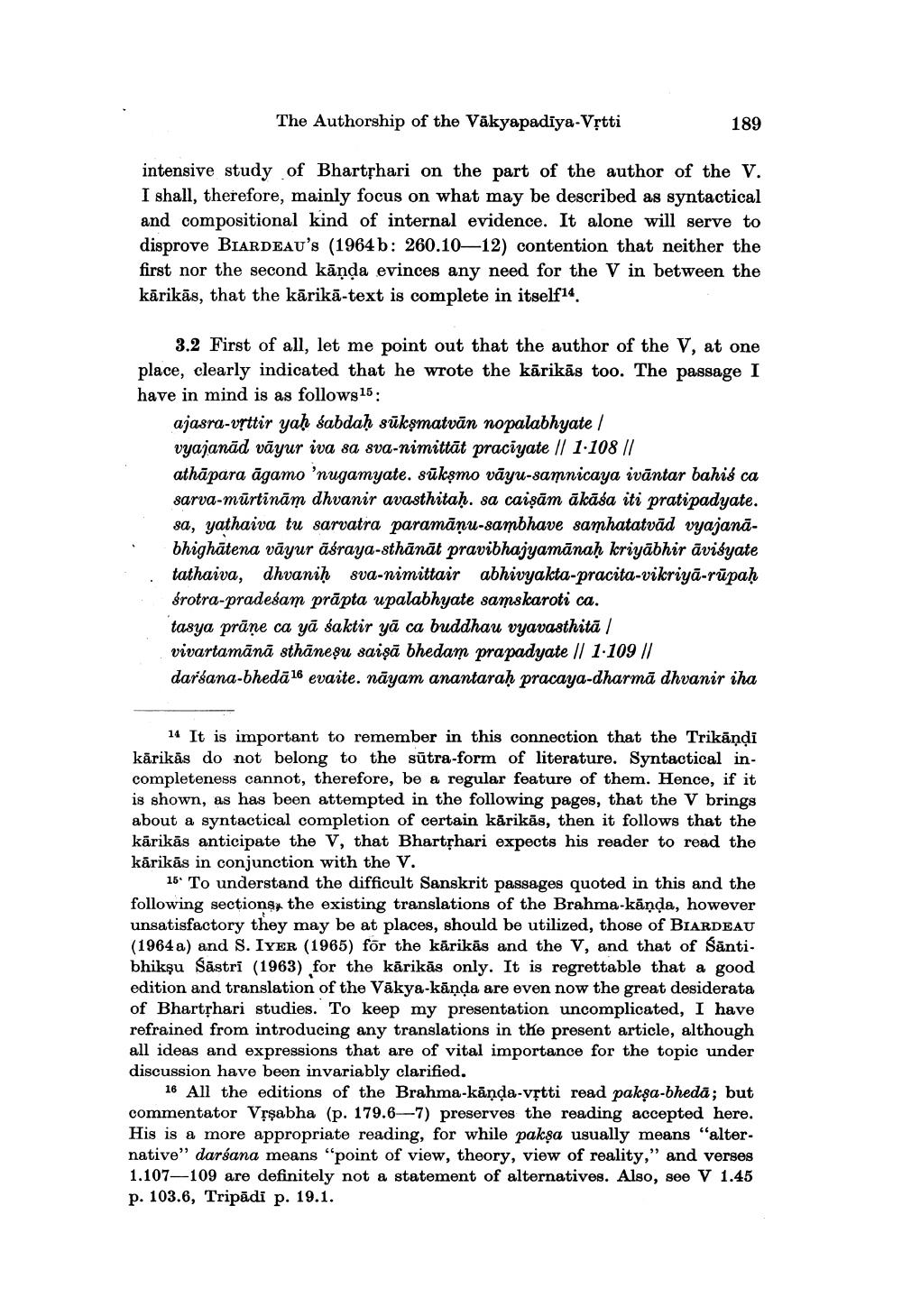Book Title: Authorship Of Vakyapadiya Vrtti Author(s): Ashok Aklujkar Publisher: Ashok Aklujkar View full book textPage 9
________________ The Authorship of the Väkyapadiya-Vrtti 189 intensive study of Bhartphari on the part of the author of the V. I shall, therefore, mainly focus on what may be described as syntactical and compositional kind of internal evidence. It alone will serve to disprove BIARDEAU's (1964b: 260.10—12) contention that neither the first nor the second kāņa evinces any need for the V in between the kārikās, that the kārikā-text is complete in itself14. 3.2 First of all, let me point out that the author of the V, at one place, clearly indicated that he wrote the kārikās too. The passage I have in mind is as follows15: ajasra-vrttir yah sabdaḥ sūksmatvān nopalabhyate / vyajanād vāyur iva sa sva-nimittāt praciyate // 1.108 // athāpara āgamo 'nugamyate. sūksmo vāyu-samnicaya iväntar bahis ca sarva-mūrtinām dhvanir avasthitaḥ. sa caiņām ākāsa iti pratipadyate. sa, yathaiva tu sarvatra paramāņu-sambhave samhatatvād vyajanābhighātena vāyur āśraya-sthānāt pravibhajyamānaḥ kriyābhir āvisyate tathaiva, dhvanih sva-nimittair abhivyakta-pracita-vikriyā-rūpah śrotra-pradeśam prāpta upalabhyate samskaroti ca. tasya prāne ca yā saktir yā ca buddhau vyavasthitā / vivartamānā sthāneşu saişā bhedam prapadyate || 1.109 // darśana-bhedā 16 evaite. nāyam anantaraḥ pracaya-dharmā dhvanir iha 14 It is important to remember in this connection that the Trikāņdi kārikās do not belong to the sūtra-form of literature. Syntactical incompleteness cannot, therefore, be a regular feature of them. Hence, if it is shown, as has been attempted in the following pages, that the V brings about a syntactical completion of certain kårikās, then it follows that the kārikās anticipate the V, that Bhartshari expects his reader to read the kārikās in conjunction with the V. 16. To understand the difficult Sanskrit passages quoted in this and the following sections the existing translations of the Brahma-kānda, however unsatisfactory they may be at places, should be utilized, those of BIARDEAU (1964 a) and S. IYER (1965) for the kārikās and the V, and that of Santibhikṣu Sāstri (1963) for the kārikās only. It is regrettable that a good edition and translation of the Vākya-kānda are even now the great desiderata of BhartȚhari studies. To keep my presentation uncomplicated, I have refrained from introducing any translations in the present article, although all ideas and expressions that are of vital importance for the topic under discussion have been invariably clarified. 16 All the editions of the Brahma-kāņda-vștti read pakşa-bhedā; but commentator Vrşabha (p. 179.6—7) preserves the reading accepted here. His is a more appropriate reading, for while paksa usually means "alternative" darśana means "point of view, theory, view of reality," and verses 1.107–109 are definitely not a statement of alternatives. Also, see V 1.45 p. 103.6, Tripādi p. 19.1.Page Navigation
1 ... 7 8 9 10 11 12 13 14 15 16 17 18
